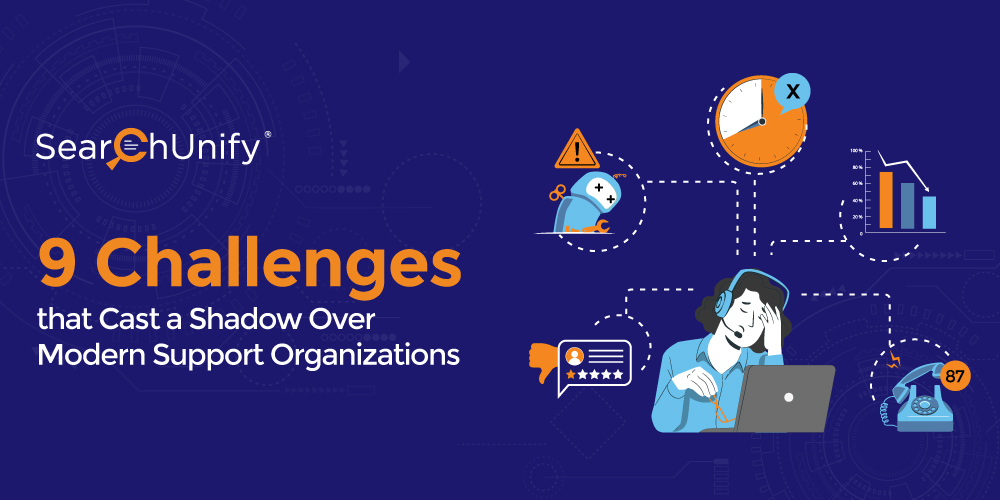
Customers today are looking for instant gratification, and organizations need to understand, meet, and exceed their expectations. Additionally, the proliferation of the internet has paved the way for enterprises to tread on the automation path and pivot towards digital-first ways of doing business.
However, not many organizations hit the nail on the head. A recent Forrester study revealed only 37% of support leaders and decision-makers are satisfied with their current digital channels and solutions. And, less than half believe they can deliver personalized support experiences at scale with it. To this end, organizations are gravitating towards technology that embraces the changing dynamics and subsequently positions them to increase their revenue.
But before we talk about that, it’s important to discuss the problems that modern support organizations are facing today.
Top Challenges Encountered by Modern Support Organizations
One bad experience and your customers will not second guess before bolting to your closest competitor. And with them goes your revenue. Given below are nine challenges confronted by organizations that could lead to mediocre or bad customer experience:
1. Variable UX Across Channels
75% of customers desire a consistent experience regardless of how they engage with a company, be it via chatbot, social media, in person, or phone. But, poorly implemented self-service channels present a challenge. For instance, the landscape orientation of a site could offer a user-friendly interface whereas, the abridged or mobile version of the same portal could be using a non-responsive web design and/or might be difficult to navigate.
2. Limited Context Personalization
A McKinsey study revealed that fewer than 10% of companies currently deploy personalization beyond digital channels in a systematic way. They’ve to make do with limited resources and outmoded technology that results in siloed customer data, restricted customer insights, and disjointed customer experiences.
3. Employing Rule-Based Bots
Companies that deploy poorly designed or rule-based chatbots can significantly hurt their bottom line since the bots fail to function as a standalone entity. Worse still, if they are posed with questions that are outside their database or beyond their scope, that’s when the infinite loop of fallback responses begins. Needless to say, these interactions irk customers and shoot the company’s reputation in the foot.
4. Limited Or Subpar Intent Detection
A lot of firms rely on intent detection for quality self-service and ticket routing. But, when it doesn’t work as intended, a mountain of problems emerge. Self-help efforts go south and agents end up with tickets beyond their area of expertise. As a result, customer and agent effort goes up, which indelibly mars CX.
5. Inefficient Case Triage and Assignment
Ticket routing is principally a backroom concept but has a profound impact on CX. Cherry-picking tickets or manually triaging them is expensive, slow, inaccurate, and mundane, which ultimately delays ticket resolution and takes a toll on customer satisfaction scores.
6. Difficulty in Finding Case Resolving Information
The best time to resolve complaints is ASAP. However, employees today are surrounded by a pool of information. And sadly, most of it is scattered across disjointed systems. So, when your search fails to provide the right answers due to inept crawling, your agents and customers get pulled into the murky waters of the vast information jungle, thereby making it difficult to access the right information at the right time.
7. Inconsistent KB Creation
Solving cases is only half the battle, the other half is documenting their resolutions. Since your agents are already juggling between multiple tasks, creating or updating knowledge bases becomes a herculean task and is often done retrospectively, thus leading to incomplete, incorrect, and inconsistent KB articles.
8. Siloed Customer Usage Insights
A customer’s perceptions and needs are likely to change throughout their journey. It takes a hawk-eyed view to understand them and personalize the experience accordingly. However, 54% of marketers say that disjointed and siloed data are the biggest barriers to leveraging customer data. Fragmented customer profiles can blight the CX by engaging prospects and leads with the wrong offer, or worse, the wrong solution.
9. Ineffective Depth and Breadth of Adoption
Without a holistic view of the customer’s journey, CSMs feel like they are finding their way out of a mine without a flashlight. They are left forsaken trying to figure out the features being used and ignored by your customers. This not only lowers product adoption but also incapacitates the success champions from suggesting the next-best course of action.
Manage Your Unintegrated Tech Stack with A Enterprise Agentic Platform
Shifting market dynamics and rising competition compel companies to embrace technological advancements, and rightfully so. The tech stacks built on the fly to gain a competitive edge without proper vetting or integration are only beneficial momentarily but beget silos in the long haul.
A enterprise agentic platform not only irons out all the kinks but also allows you to leverage customer data like the goldmine it is. It provides a birds-eye view of your consumers, thereby boosting engagement on your platform. Additionally, it leverages search analytics to revolutionize information discovery by surfacing relevant content across verticals and personalizes results based on user intent & behavior, thus elevating self-service & support outcomes.
If you’re wondering how to choose the right cognitive solution that fulfills your organizational needs, then tune in to this insightful session at TSW Vegas 2021. It will help you understand the key markers that characterize the decision to invest in cognitive technology and the strategic value of investing in AI-powered applications.











